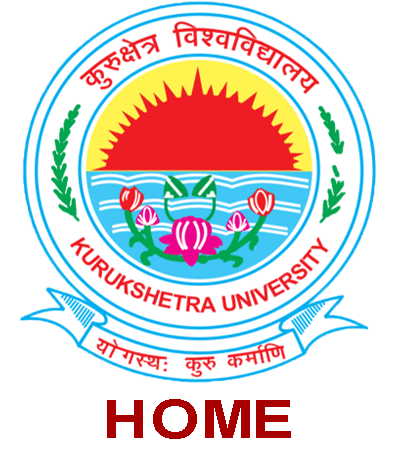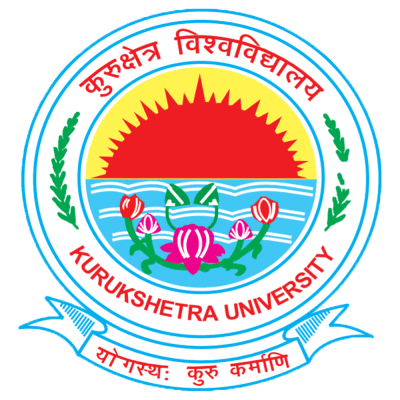Doctoral
Programme Information (Doctoral)
|
Doctoral Programmes |
|
|
Name of the Programme |
Ph.D. in Applied Geophysics |
|
Scheme of the programme |
DEPARTMENT OF GEOPHYSICS KURUKSHETRA UNIVERSITY KURUKSHETRA
Ph. D. Course Work (Main Subject)
Paper-I: Research Methodology Time: 03 Hours Credits: 04 Note: Five questions will be set and students are required to attempt four questions in all. Question No. 1 will be compulsory. Geostatistics and Error Analysis: concepts of mean, mode, median, correlation, Attenuation relation/regression, Deterministic and probabilistic seismic hazard techniques, earthquake source parameters and their estimation, concept of magnitude and intensity scales, earthquake localization and seismic phases; Origin of Himalaya, tectonics & seismicity of Himalaya, different models of Himalaya, Basics of signal processing, DFT, FFT, fundamentals of linear and non-linear inverse problems and solutions, Ethics in research, Kurukshetra University palagrism rules and regulations, Meaning of H-Index, I-10 index, Impact Factor, citation index of different agencies, way of writing references.
Paper-II: Subject Elective
Time: 03 Hours Credits: 04 Note: Five questions will be set and students are required to attempt four questions in all. Question No. 1 will be compulsory. Concept of strong motion: characteristics of earthquake strong ground motion, time domain and frequency domain parameters of strong ground motion, strong motion array and recorder, dynamics of vibration, vibration of a single degree of freedom system, earthquake response spectra, Strong motion networks in India, Modelling of strong ground motion: Stochastic modelling technique, concept of dynamic corner frequency, Empirical Greens function technique, Semi empirical technique and Composite source modelling technique, hybrid technique.
Wave attenuation: geometrical spreading, scattering and intrinsic attenuation, Quality factor Q and its estimation using frequency domain methods, origin of coda waves, coda-Q and its estimation, estimation of frequency independent and frequency dependent Q using strong ground motion, simultaneous estimation of source parameters and Q, concept of 3-D Q and its estimation.
Concept of earthquake hazard, vulnerability and risk, probabilistic versus deterministic approach of estimating earthquake hazard, seismic quiescence/gaps, Regression analysis for estimating peak ground motion, microzonation, site amplification, concept of earthquake resistant design, Indian earthquake hazard scenario. Receiver functions, Seismicity based studies- b-value, fractal and multifractal analysis, Dq-q analysis, self similarity, Ray tracing, Anisotropy, Time predictable model, GPS based studies in seismology,
Paper-III: Term Paper
Note: There will be no written test of Paper-III (Term Paper). However, the evaluation of Seminar and Research Assignment/literature/survey etc. will be done by the Departmental Research Advisory Committee.
It will comprise of the following two activities: (i) Seminar in the thrust area(s) of the research work: 02 credits (ii) Research assignment/ literature/survey, etc. : 02 credits
For above two activities, students are required to contact their respective supervisors
DEPARTMENT OF GEOPHYSICS KURUKSHETRA UNIVERSITY KURUKSHETRA
Ph. D. Course Work
Paper-I: Research Methodology
Time: 03 Hours Credits: 04 (100 Marks)
Note: Five questions will be set and students are required to attempt four questions in all. Question No. 1 will be compulsory. Geostatistics and Error Analysis: concepts of mean, mode median, correlation, regression analysis. Solutions of linear inverse problems: Least square solution, Minimum length solution,damped least square solution, Solution of non-linear inverse problems: Iterative methods. A brief description of Global optimization techniques: Genetic algorithm, Simulation annealing techniques.
Paper-II: Subject Elective
Time: 03 Hours Credits: 04 (100 Marks) Note: Five questions will be set and students are required to attempt four questions in all. Question No. 1 will be compulsory. Principles of Gravity method, concept of Geoid, Spheroid, variation of gravity with elevation and depth, determination of density, isostasy and gravity. Gravity Prospecting Instruments: Absolute versus Relative measurements of Gravity, Pendulum apparatus, stable and unstable gravimeters, calibration of gravimeters, LaCoste-Romberg gravimeter, Wordern gravimeter. Gravity survey on land: setting up of a base station, tide and drift corrections, the reduction of gravity data: the latitude adjustment, the elevation adjustment, the excess mass adjustment, terrain correction, Derivation of expressions for Bouguer correction and Terrain correction, Gravity anomalies: Bouguer anomaly, Free air anomaly and Isostatic anomaly, Gravity anomaly and isostasy. Applications of gravity method in oil and mineral exploration. Separation of residual and regional anomalies: Graphical method, direct computation, second derivative method, polynomial fitting method, wavelength filtering, downward continuation.
Paper-III (a) Research and Publication ethics
Time: 2 Hours Credits: 02 (50 Marks) Note: Three questions will be set and students are required to attempt two questions in all. Philosophy and Ethics: Introduction to philosophy and ethics, Scientific Conduct: Ethics with respect to science and research, Kurukshetra University plagiarism rules and regulations, Publication Ethics: Best practices, conflicts of interest, Publication mis-conduct.
Impact Factor of journals, Matrics: h-Index, g-index, i-10 index, citation index of different agencies, ways of writing references. Developing research proposal in the field of Geosciences. Research approach and identifying gap areas from literature review; problem formulation and statement of research objectives.
(b) Seminar in Thrust area/Research Assignment/Literature Survey etc Credits: 02 (50 Marks) Note: There will be no written test of Paper-III (b). However, the evaluation of Seminar and Research Assignment/literature/survey etc. will be done by the Departmental Research Advisory Committee.
It will comprise of the following two activities: (i) Seminar in the thrust area(s) of the research work: 01 credits (ii) Research assignment/ literature/survey, etc. : 01 credits
For above two activities, students are required to contact their respective supervisors
|
Haryana
Copyright © 2020 Kurukshetra University, Kurukshetra. All Rights
Reserved.
Powered by: Dexpert Systems
Pvt Ltd

